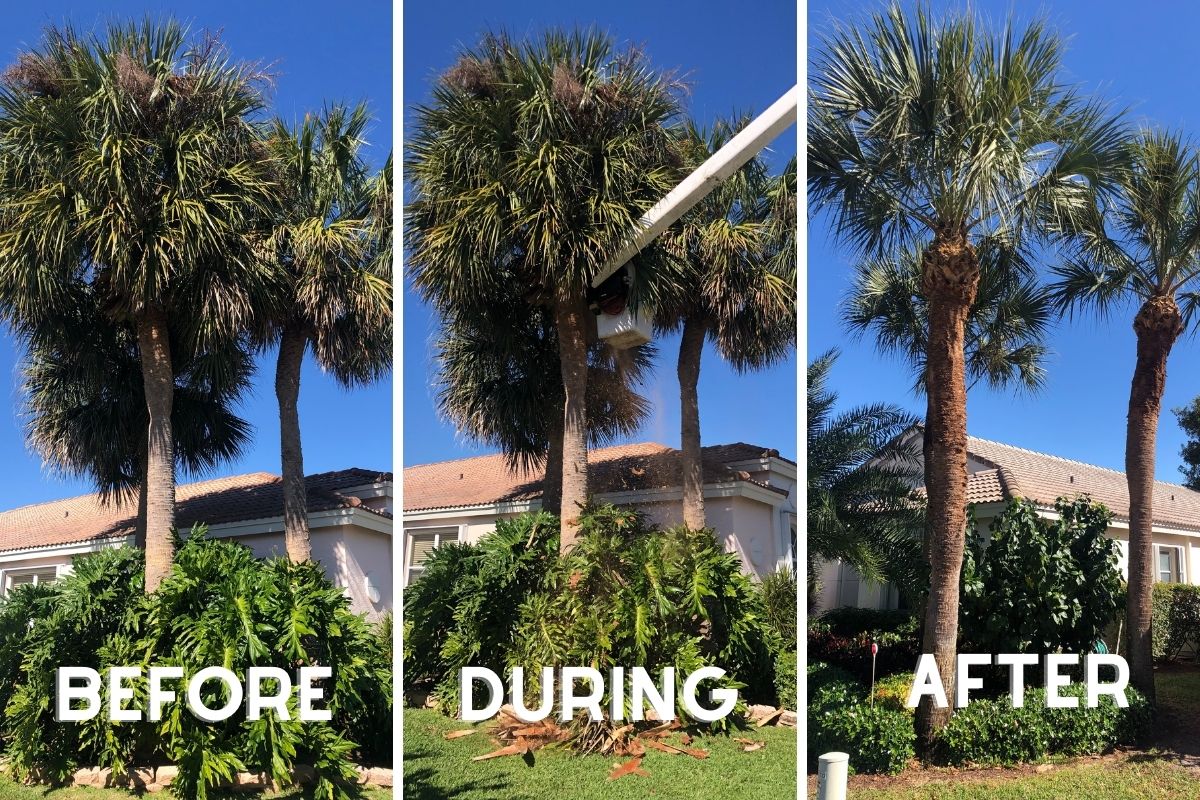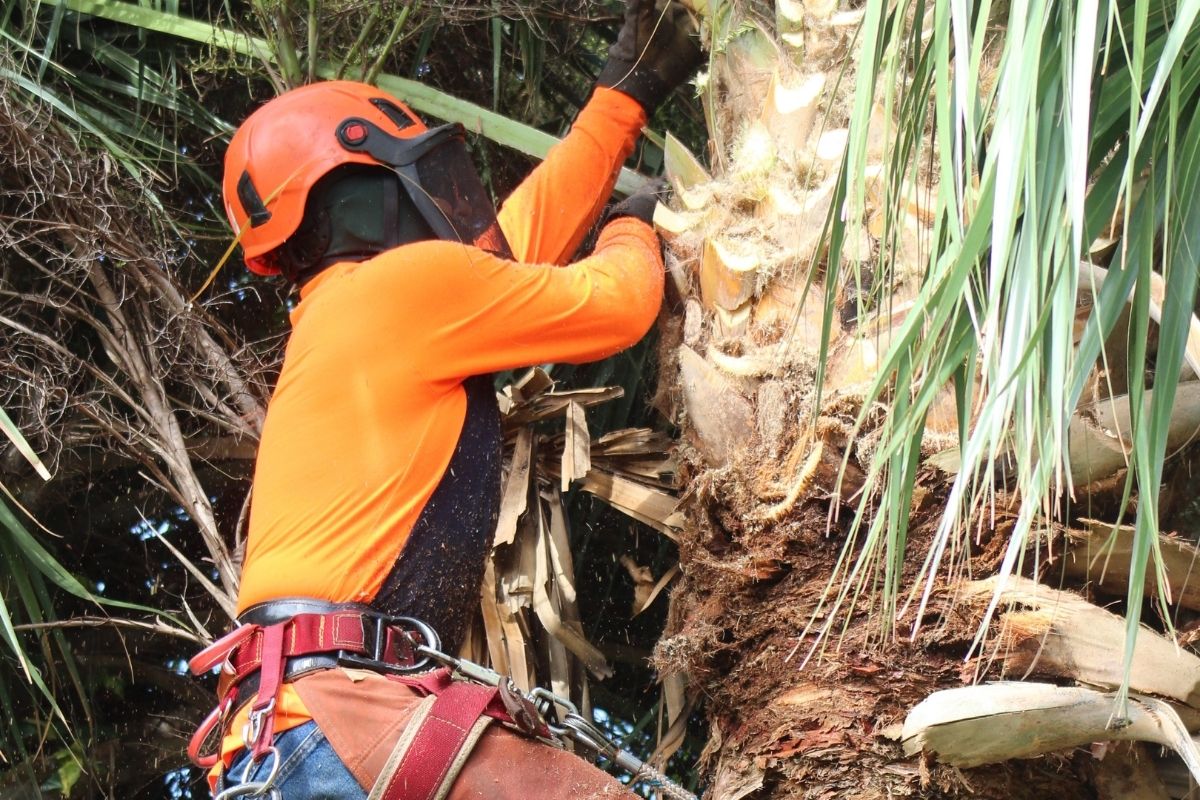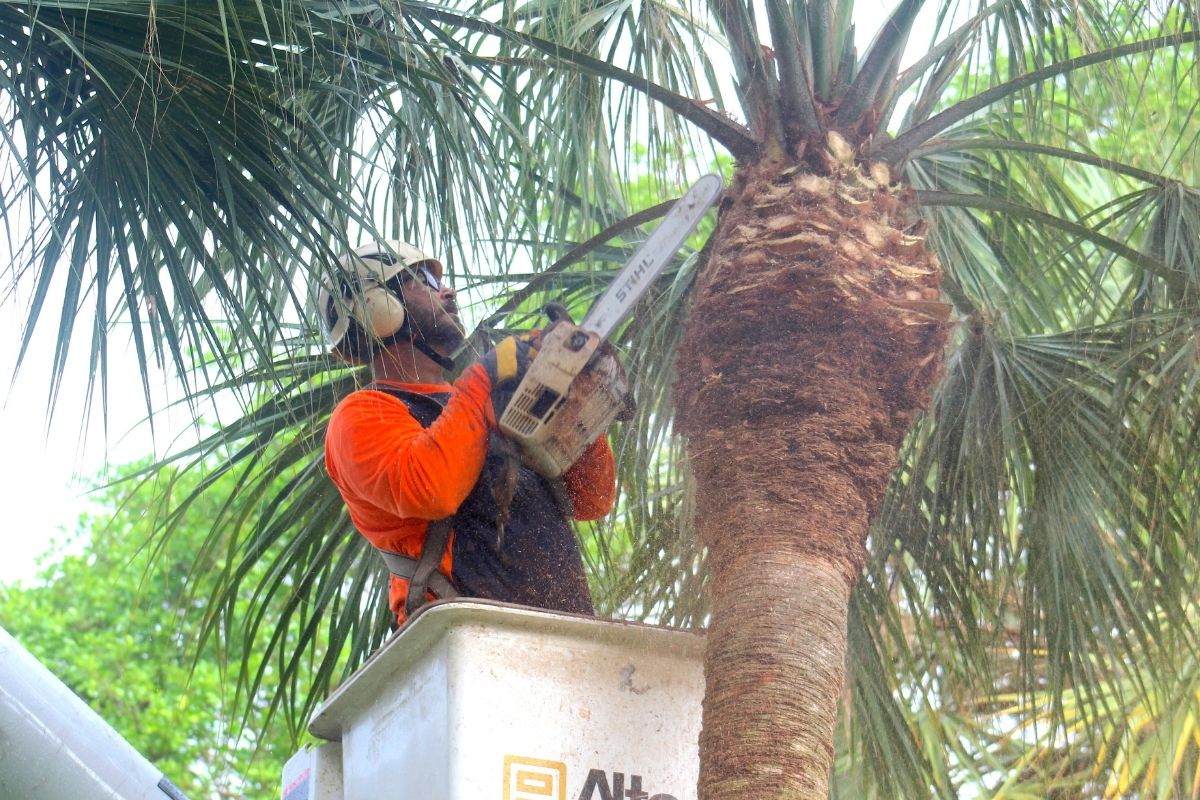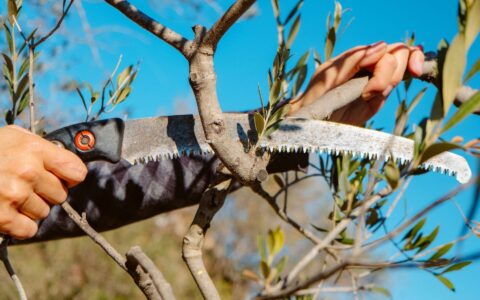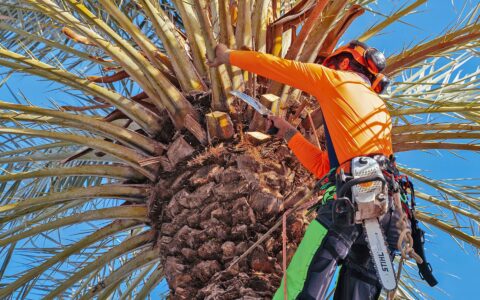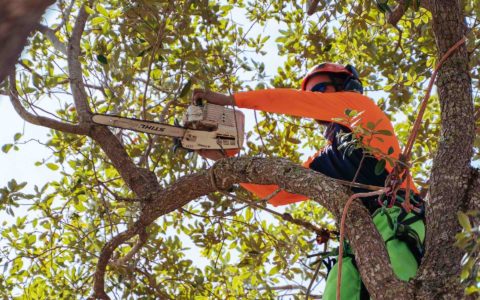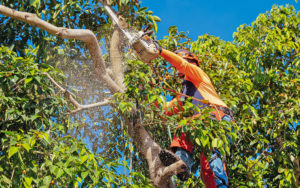Palm trees – the ultimate symbol of relaxation. People come to South Florida from all over the world to see our turquoise waters, white sandy beaches, and take pictures with our majestic palm trees swaying gently in the breeze. But those swaying beauties need more than sunshine and sandy beaches to thrive – proper palm tree trimming is a critical piece of keeping them healthy.
In the Sunshine State, where palm trees are practically a way of life, knowing how to properly trim these trees is key to keeping them healthy. Hack jobs with the wrong tools can leave your palms looking like sad, ugly feather dusters, or worse, expose them to disease and storm damage.
In This Palm Tree Trimming Guide
In this guide, you’ll get all the answers to your palm pruning questions, including:
- Which palms need trimming, and which don’t
- What a “self-cleaning” palm is
- Whether or not you need to trim self-cleaning palms
- How to properly prune a palm tree
- Palm trimming mistakes to avoid
- How many palm fronds to remove when pruning
- The best time to prune palm trees in South Florida
- How often to trim your palms
- What a properly pruned palm tree should look like – and NOT look like
- Hurricane trimming for palms – do they need a “hurricane haircut”?
- When you can trim your own palms and when it’s best to call in a tree service for palm pruning
Did You Know …
Palms are not actually trees – they belong to a group called monocots, along with other plants like corn, lilies, onions, and orchids. Unlike dicot trees, monocots have a single growing point at the top and a simpler vascular system. This combination is why a palm’s trunk doesn’t get thicker as it matures. Instead, palms produce new fronds from this single growing point throughout their lifespan. Other characteristics of monocots include long parallel veins in their leaves and having only one seed leaf (cotyledon).
Which palms need trimming?
South Florida has a lot of palm tree species, and the first step in caring for your palm is identifying its type. While flowers and fruit are some of the most common ways to ID many plants, you might still be stumped. Thankfully, there are many palm tree identification resources online to help.
Palms that need pruning are those that hang on to their fronds even after the frond has browned and died. While it isn’t strictly required, these fronds are usually removed for aesthetic reasons, safety concerns, and to keep vermin from making a home in them.
Common palm species in and around Broward County that benefit from regular trimming to remove dead fronds include:
- Coccothirnaxargentata, the Silverpalm
- Cocos nucifera, the Coconut palm
- Phoenix canariensis, the Canary Island palm
- Syagrusromanzoffiana, the Queen palm
- Thrinax radiata, the Thatch palm
What is a self-cleaning palm?
On the other hand, some palm tree species don’t need to be trimmed because they regularly shed their older, dead palm fronds without assistance. These types of palm trees are called “self-cleaning” and include the following:
- Roystonea regia, the Royal palm
- Sabal palmetto, the Sabal Palm or Cabbage palm, and the state tree of Florida
- Veitchiamerrillii, the Christmas palm
- Washingtoniarobusta, the Fan palm (may need pruning when young; read below)
The main difference between palms that drop their dead fronds and those that don’t is what’s called a crownshaft. This is the area at the top of the palm trunk where fronds grow. You can usually identify it because of its smooth, waxy-looking surface that lacks the familiar hairy or fibrous look of the trunk.
The crownshaft is where fronds are attached while they’re growing. Like deciduous trees in the fall, self-cleaning palms shed their fronds at the end of their growing cycle. The palm severs the vascular connection that provides water and nutrients, and the frond dries and falls to the ground – usually within 2 to 3 days.
Do you ever need to prune a self-cleaning palm?
It’s important to note that just because a palm tree is considered “self-cleaning,” it doesn’t mean they don’t need any attention from time to time.
The fan palm is a good example. When it’s young, the fan palm makes a lot of fronds quickly and doesn’t drop them all. As it matures, it produces fronds more slowly and regularly drops them when new fronds emerge.
The build-up of dead fronds on young fan palms should be removed, as the skirt-like mass of dry fronds is a favorite place for rats, snakes, and insects to move into. Fortunately, young fan palms are shorter than their mature 80-foot plus height, so removal is easier.
How to Trim a Palm Tree Correctly
Palm trees are beautiful additions to any landscape, but correctly caring for them is what keeps them healthy and thriving. There are a few things to remember when properly pruning your palm trees so you can ensure South Florida’s palms continue to be a symbol of relaxation and paradise for years to come.
Target the Right Parts When Pruning Palms
Palms grow differently from regular trees. They have a single terminal bud, or top shoot, at the top that produces all new growth. Never prune or damage this area because you can wind up killing the entire palm. Instead, focus your trimming efforts on the lower portion of the palm, removing only dead or dying fronds.
Safety First: Palms Can be Dangerous
Protect yourself with a helmet, gloves, eye protection, and long sleeves and pants. Some palms have sharp spines that can cause serious injury. Fronds can be heavy and fall unexpectedly, so it’s important you stand clear of the cutting zone.
You also must remember to clean your pruning saw before starting and between cuts. Any pathogens that may be on your blade will be transferred into your palm when you saw through the stem, or petiole, of a frond. Water with bleach added is one of the most common sanitizing methods for cleaning pruning tools and an easy way to prevent disease transmission.
Where to Make the Cut
When you’re removing fronds, keep your saw blade a couple of inches away from the point where the frond attaches to the main trunk or stem. You don’t want to cut into or tear the main stem, as this leaves an opening for fungal diseases and insects to get in. The short stub left at the point of attachment will dry out and fall eventually.
Leave the Tall Palms to the Professionals
While it is possible to use a pole saw to reach high fronds, it’s impractical if you aren’t a professional. It is easy to lose control and precision with your cuts, making it difficult to see any potential damage you might cause. And using a pole saw while standing beneath a thick skirt of dead fronds is dangerous, as fronds can fall without warning.
NOTE: For any palm, pruning is a good idea if dead fronds are a fire hazard.
How many fronds should I remove from my palms?
The first thing to know about proper palm tree trimming is that you should remove only dead fronds. Any fronds that are still green should be left in place. A palm tree’s fronds photosynthesize and make energy stores for the palm to grow. Cutting off a living frond reduces the palm’s ability to make food energy, and you want to keep your palms vigorous and healthy.
Fronds that are declining but not dead should generally not be removed as they are important to the health of the palm. Fronds that are yellowing but still alive probably indicate a nutrient deficiency, particularly potassium or magnesium (soils in many parts of South Florida are lacking in these nutrients). Removing still-living fronds prevents those fronds from transferring nutrients to newly developing fronds at the terminal bud.
If you must remove living fronds for safety or because of space limitations, remove no more than 25% of the total amount of foliage. As with trees, removing too much living, photosynthesizing foliage at one time can stress your palm and compromise its overall health.
What should my trimmed palm look like?
For most palms, the ideal shape is a round canopy with green leaves right down to the bottom. Palms are supposed to have round crowns, not feather-duster crowns.
When you remove fronds, keep the overall appearance of the palm in mind. While palms aren’t like spreading shade trees, they can develop large crowns of fronds. Stop removing fronds when the crown of your palm forms a semi-circular shape – the fronds should reach the 9 and 3 o’clock positions (or below), but not any higher.
Should you prune off flowers and/or fruit from palms?
Some people don’t want palm fruit to remain on their palms and choose to have the flowering and fruiting stalks removed. Before removing these fruiting stalks, remember that birds and bats, as well as pollinators, all enjoy the flowers and fruit. And as it’s birds and bats that eat the insects that we hate, leaving a tasty snack on your palm is a nice thank you.
Of course, don’t leave fruit on your palms if fruit-drop causes issues with safety or mess on the ground, or if vermin are attracted to the fruit. For example, Queen palms produce a lot of fruits that create a huge mess. Plus, the seeds germinate easily, resulting in weeds all over your property. Coconut palms are another tree where you’ll probably want to remove the fruit before they fall and hit someone.
What about hurricane pruning?
There are a few good tips on preparing your trees for hurricane season that you should follow, but the infamous “hurricane haircut” is not one of them.
Hurricane trimming on palm trees involves cutting off all but a few of the youngest fronds at the top of the tree, creating a “feather duster” look. It’s often done in the mistaken belief that having fewer leaves will protect the tree when hurricanes hit.
Some people ask to have their palms cut this way thinking it will save them money as they won’t have to pay for palm trimming as often. You’ve likely seen many of these oddly shaped palms throughout South Florida, but that doesn’t mean you should do it, too. Because excessive pruning weakens the tree, leading to health issues and decline, the long-term tree care costs for the palm will exceed any short-term cost savings.
Why shouldn’t my palms get a “hurricane trim”?
The reality is palm trees are adapted to windstorms, and palms that have been subjected to a “hurricane haircut” are actually less resilient. Here’s why:
- Weakens Remaining Fronds: A full canopy protects the younger fronds. Without that support, the remaining few whip around in strong winds and eventually snap off.
- Results in Nutrient Loss: Even older fronds still produce nutrients the palm needs. Excessive pruning weakens the tree overall, hindering its ability to recover from storm damage.
- Exposes the Terminal Bud: Excessive hurricane pruning removes fronds that shield the important terminal bud, the part of the tree responsible for producing new fronds. Leaving the terminal bud exposed makes it extremely vulnerable to wind, storms, and cold weather.
- Increases Risk of Disease: Every pruning cut creates an opening for pests and diseases. The fewer cuts made, the better for the palm tree’s overall health.
- Doesn’t Reduce Wind Damage: Excessive pruning does NOT make your palm safer from hurricanes! Palms are designed to be flexible and move with the wind. Their crown is not so dense that wind can’t pass through fronds. Removing a large percentage of fronds only causes unnecessary stress for the palm tree.
As tree care professionals, the best piece of advice we can give you about “hurricane haircuts” is if you’re told that this type of heavy pruning helps the palm, find someone else to do your pruning!
What if my palm tree is diseased? Should I trim out the diseased parts?
Heavy pruning recommendations are different if you have a diseased palm, such as one affected by lethal bronzing or lethal yellowing.
In this case, it may be important to remove as many diseased fronds as possible to reduce the volume of diseased foliage or pathogens. This is a job that should be done by professionals who can identify diseases and know what methods to use to mitigate disease transmission.
How often should I prune my palms?
Palm tree pruning is done primarily for aesthetic reasons so the frequency depends on whether you like the look of dead fronds on your palm or not. Most people trim their palms once a year, although some businesses may do it more often (e.g., twice a year) to maintain a “neat and tidy” appearance.
However, excessive frond loss, especially on your younger palms, can be a cause for concern and might indicate a disease or pest problem, or some other palm tree health problem. If you notice this happening, it’s best to consult with a certified arborist.
If you don’t like dead fronds, you’d ideally prune them off as soon as you notice them. However, that’s just not practical unless the palm is in your own yard and is small enough to easily reach the fronds from the ground with common pruning tools.
What’s the best time of year to trim palms in South Florida?
Palms grow year-round in warm climates like South Florida so it doesn’t really matter when they’re pruned; there’s no one time of year that’s better than others.
You may want to prune out dead fronds before hurricane season arrives to minimize the risk of them breaking off and hitting something. But only remove dead fronds; removing live fronds doesn’t make your palm safer in a hurricane.
It’s also better to do any major palm tree trimming well before periods of heavy or prolonged rain. Moisture and warm temperatures create ideal conditions for fungal growth. You’ll want any pruning cuts to have a chance to seal before pathogens have a chance to get in.
Among the fungal diseases that can attack palms, Fusarium wilt stands out as one of the most severe. There is no cure or way to control this fungal disease once it finds its way into your palm, so prevention is key. Fan palms, Queen palms, and Canary Island palms are examples of palm species that are killed by fusarium wilt.
When should I hire a professional to prune my palms?
Once fronds are out of reach from the ground, you should hire a professional palm trimmer. The risk of injury is too great, and the work is harder than many people think.
Homeowners are known for underestimating the danger and difficulty of tree work they think they can DIY, but the risk is real. Safety reports show that unlicensed, untrained palm trimmers and homeowners die every month from suffocation or being crushed under the weight of heavy palm fronds.
Major safety organizations recommend that only workers certified by organizations such as the Tree Care Industry Association (TCIA) or the International Society of Arboriculture (ISA) should perform or supervise palm tree trimming.
Professionals have the equipment, protective gear, crew size, and training needed to do a fast, efficient, and safe job pruning your palms. Plus, they’ll remove all the frond debris when they’re finished. And there’s a lot of debris!
Lifts and cranes are used to inspect palm crowns and to reach high fronds safely. And tree care professionals don’t climb palm trunks while wearing climbing spikes. As with trees, these spikes can injure the trunk of your palm and create openings for the disease.
When you are comparing bids for palm trimming, keep in mind the value of an experienced, professional, and insured crew. While low prices are attractive to everyone, ending up with a badly or excessively pruned palm or a palm that has been infected with a fungal disease from unsanitary tools is not a worthwhile outcome.
Call Sherlock Tree for Healthy, Beautiful Palm Trees in South Florida
Your palms, and all your trees, are long-term investments that enhance your garden and increase the value of your property. Treat them well and you’ll enjoy all their benefits for a long time while saving money in the long term.
Sherlock Tree Company is here to help with any of your tree care needs, including palm tree pruning. We’ll evaluate your palms, give you sound advice, and an honest estimate for proper palm tree trimming.
The best part? Sherlock Tree Company is accredited by the TCIA (we’re one of only a few tree service companies in South Florida who’ve earned accreditation) and we have several ISA Certified Arborists on staff. So, you can be sure palm trimming is done safely and correctly.
Call Sherlock Tree Company today at 954-788-4000 or conveniently request an estimate for palm trimming on our website. Your palm trees will thank you!
Call Sherlock for quality tree services
Whether you're looking for specific tree care services, such as palm trimming, tree removal, or disease treatments, or would like one of our Arborists to examine your trees to identify any issues and recommend options, we're always here for you! Just give us a call at 954-788-4000 to set up an appointment.
SEE MORE ARTICLES
Looking for more?
We've got you covered with a monthly newsletter full of tips, resources, updates, how-to's, and other helpful information about trees and landscapes in South Florida!

